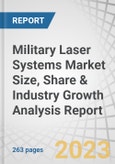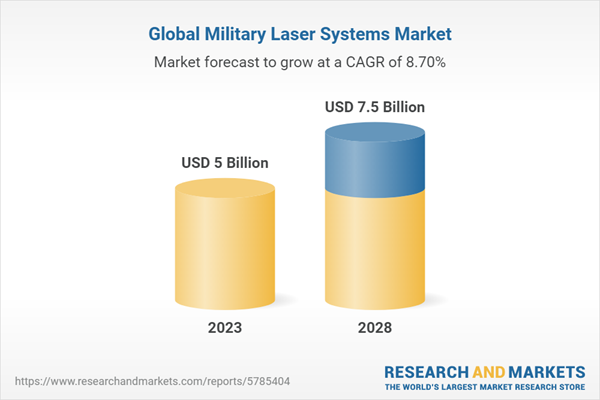The global military laser systems market size is projected to grow from USD 5 billion in 2023 to USD 7.5 billion by 2028, at a CAGR of 8.7% during the forecast period.
Directed Energy Weapon Segment: The largest share of the military Laser systems market by end use in 2023
The directed energy weapon segment held the largest share of the military Laser systems market by end use in 2023. The defense sector witnessed increases in the integration of directed energy weapons on military platforms such as naval ships, fighter aircraft, armoured vehicles, and satellites. In recent decades, several defense manufacturers and integrators have been researching and developing laser weapons, which are now widely being rapidly adopted ing by several defense forces to enhance their defense capabilities.
In March 2021, Raytheon Intelligence & Space was awarded a USD 15.5 million contract by the US Air Force Lifecycle Management Center to build and deliver an upgraded version of its high-energy laser weapon system, or HELWS. Moreover, In January 2021, Rheinmetall AG and MBDA won a contract to develop a naval laser weapons system for the German Navy. In addition, in August 2022, Lockheed Martin Corporation delivered the high-energy laser to US Navy. The high energy laser weapon was installed on warships, which is a 60KW+ laser and is officially known as High Energy Laser Integrated Optical-Dazzler and Surveillance (HELIOS).
10-100 kW Segment: The largest segment of the military Laser systems market by output power in 2023
The 10-100 kW segment has the largest segment of the military Laser systems market by output power in 2023. The laser systems that generate an output power of 10-100 kW are widely used in target acquisition, tracking, and destruction, as well as communication and sensing applications. In the military, 10-100 kW laser systems are used for anti-missile systems, air defense, and ground-to-air defense, among others. By using the capabilities of medium-energy laser systems, defense systems can take down enemy missiles and aircraft with pinpoint accuracy from a distance without causing harm to nearby people or infrastructure.
Asia Pacific to account for the second largest CAGR in the military Laser systems market during the forecasted year
The demand for military laser systems in Asia Pacific has increased in recent years due to rapid economic development, rising security threats, and increased border disputes. The military spending of China, Japan, and India has been growing in recent years due to the increased possibility of being targeted by terrorist attacks. Recent conflicts between various countries of the Asia Pacific region, such as North Korea and South Korea, Japan and China, and India and Pakistan, among others, are driving procurements and investments in armored vehicles in this region.
Break-up of profiles of primary participants in the military Laser systems market:
- By Company Type: Tier 1 - 35%, Tier 2 - 45%, and Tier 3 - 20%
- By Designation: C-Level Executives - 35%, Directors - 25%, and Others - 40%
- By Region: North America - 40%, Europe - 20%, Asia Pacific - 30%, Rest of the world - 10%
Prominent companies in the military Laser systems market are Northrop Grumman Corporation (US), Raytheon Technologies Corporation (US), Lockheed Martin Corporation (US), Thales Group (France), and BAE System plc (UK), among others.
Research Coverage
The market study covers the military laser systems market across segments. It aims at estimating the market size and the growth potential of this market across different segments, such as application, platform, technology, end use, output power and region.
The study also includes an in-depth competitive analysis of the key players in the market, along with their company profiles, key observations related to product and business offerings, recent developments, and key market strategies. Key benefits of buying this report: This report will help the market leaders/new entrants in this market with information on the closest approximations of the revenue numbers for the overall military laser systems market and its subsegments. The report covers the entire ecosystem of the military laser systems industry and will help stakeholders understand the competitive landscape and gain more insights to better position their businesses and plan suitable go-to-market strategies. The report will also help stakeholders understand the pulse of the market and provide them with information on key market drivers, restraints, challenges, and opportunities.
The report provides insights on the following pointers:
- Analysis of key drivers and there are several factors that could contribute to an increase in military laser systems market
- Product Development/Innovation: Detailed insights on upcoming technologies, research & development activities, and new product & service launches in the military laser systems market
- Market Development: Comprehensive information about lucrative markets - the report analyses the military laser systems market across varied regions
- Market Diversification: Exhaustive information about new products & services, untapped geographies, recent developments, and investments in the military laser systems market
- Competitive Assessment: In-depth assessment of market shares, growth strategies and service offerings of leading players like Northrop Grumman Corporation (US), Raytheon Technologies Corporation (US), Lockheed Martin Corporation (US), Thales Group (France), Elbit System Ltd. (Israel), and BAE System plc (UK), among others in the military laser systems market
Table of Contents
Companies Mentioned
- Alpha Design Technologies
- Aqwest LLC
- Bae Systems PLC.
- Bluehalo
- Coherent Corp.
- Dynetics
- Elbit Systems Ltd.
- Frankfurt Laser Company
- Hensoldt AG
- Kord Technologies
- L3Harris Technologies, Inc.
- Leonardo Spa
- Lockheed Martin Corporation
- Lumibird SA
- MBDA
- Mynaric AG
- Newport Corporation
- Northrop Grumman Corporation
- Raytheon Technologies Corporation
- Rheinmetall AG
- Roketsan As
- Safran SA
- Textron Inc.
- Thales Group
- The Boeing Company
Table Information
| Report Attribute | Details |
|---|---|
| No. of Pages | 263 |
| Published | April 2023 |
| Forecast Period | 2023 - 2028 |
| Estimated Market Value ( USD | $ 5 Billion |
| Forecasted Market Value ( USD | $ 7.5 Billion |
| Compound Annual Growth Rate | 8.7% |
| Regions Covered | Global |
| No. of Companies Mentioned | 25 |









